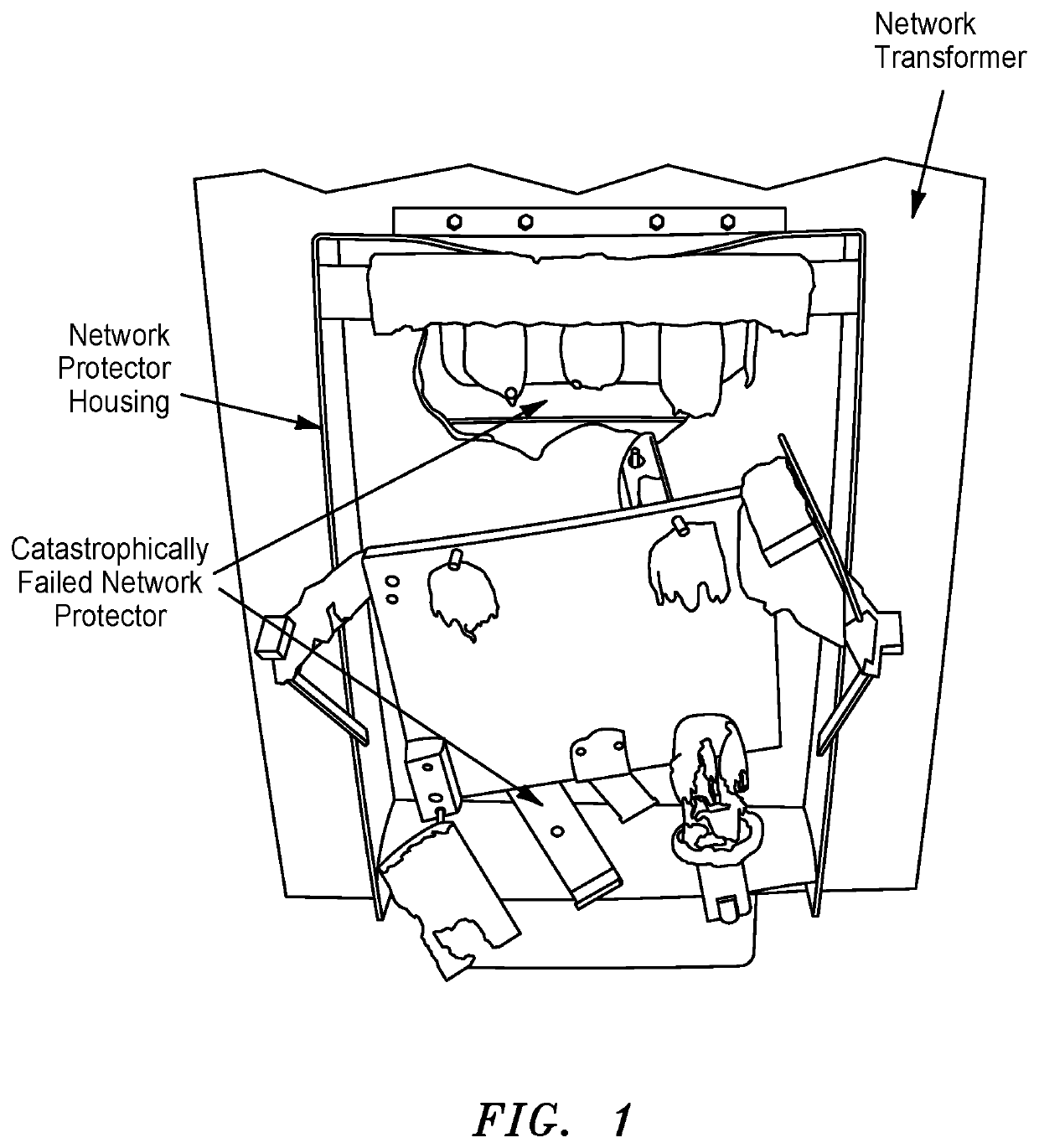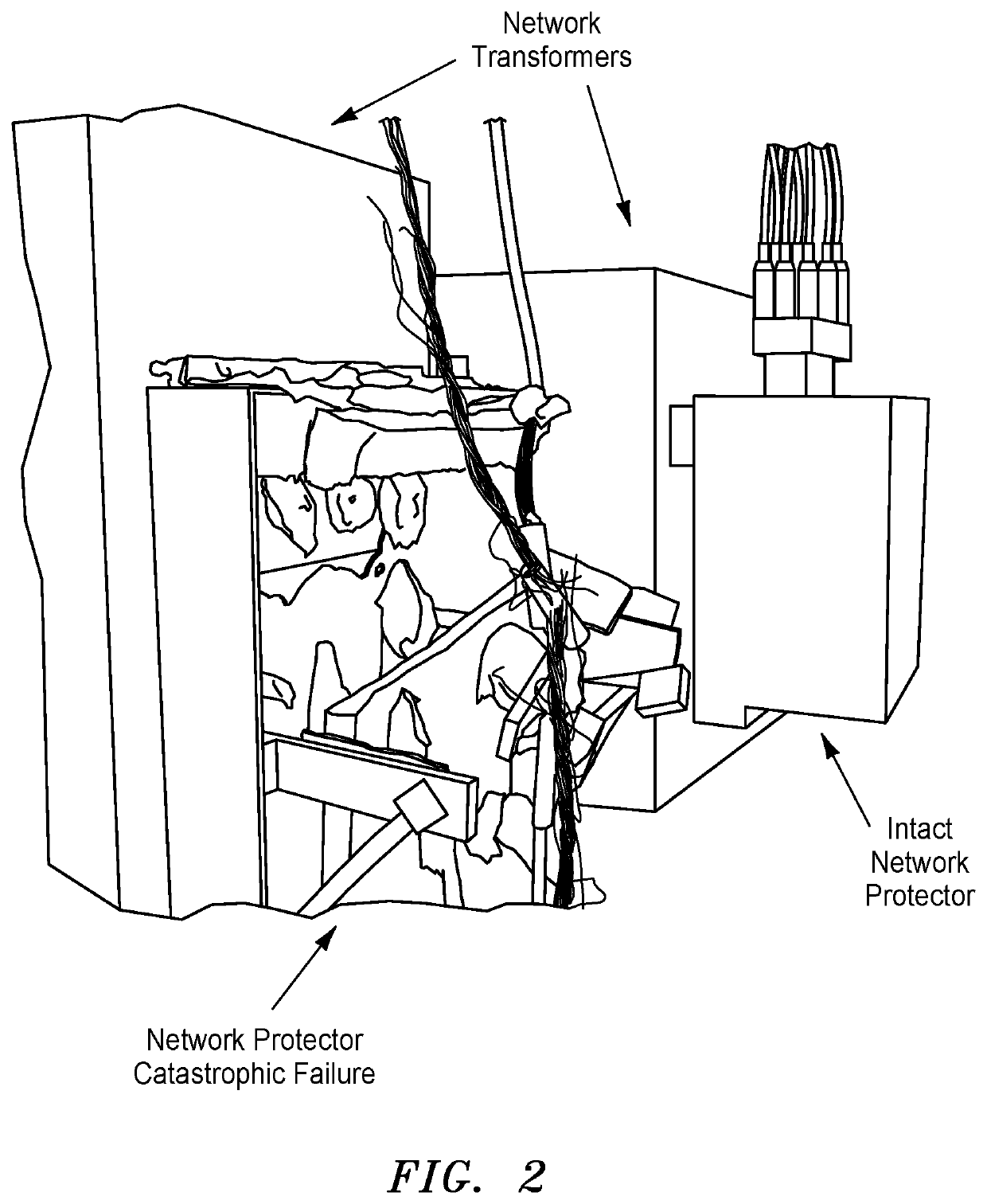These network transformers also often operate in confined, wet, contaminated, and stagnant locations.
However, after a
solid primary cable fault, every protector fed from that cable must be inspected for slow operation, contact burning, or other damage.
Any suspected damage is cause for immediately scheduling maintenance.
One of the failure scenarios with network protectors occurs when one fails to disengage from a network that is experiencing from an arcing fault wherein the average fault current is below the trip level for which the protector was set.
This failure mode is frequent when using prior art network protectors that may continue to feed power into a damaged circuit when there is an arcing fault.
A failure of a feeder cable that resulted in a
single phase short-circuiting to ground led to a series of events that resulted major losses, including
electrical isolation of an entire
city block for several days.
The vault fire could not be extinguished for several hours, leaving a heavy plume of sooty
black smoke to be ingested into building ventilation systems, including a newly restored historic theater.
The fire was so intense that it destroyed the two-transformer vault.
Because the
network protector failed to respond to the short-circuited primary cable, and resulting
high frequency arcing events (i.e., arcing fault), power flowed from the network back through the transformer, and into the shorted cable.
This caused one of the current paths inside the transformer to overheat and burn away, resulted in a horizontal breach through the steel tank, as shown in FIG. 6.
The cables feeding the transformer overheated and a fire ensued.
If oil vapor escaping from the transformer through the hole had accumulated and ignited, an explosion and major event would have followed.
Unfortunately, the network protectors of the prior art do not detect this type of situation, with particular respect to the individual
high frequency, transient arcing events that, collectively define a ‘fault event’.
Though some designs have included a shrouded
enclosure over the internal fuses, the fuses are not fully enclosed.
However, it is typically not the network protector manufacturers who undertake the external fusing.
Thus, there is often very limited clearance above a network protector that allows for installation of external fusing.
In many cases, this is impossible with the present generation of fuses.
Network protectors have historically suffered from reliability issues.
Most problematic is a failure to open during a
high energy event.
This costly effort was undertaken due to chronic unreliability of the network protectors and the potentially and often dire consequences of a protector failing to operate correctly in a contingency situation.
Maintenance is also a critical issue for the present network protectors and there are many challenges involved.
Internal
corrosion concerns also exist and may include:1)
Moisture penetration not typically obvious through the
viewport; and2)
Corrosion of sensitive components, often not apparent without detailed out-of-service inspections functionality testing failure.
Fundamental complaints regarding maintenance issues include:1) The complex mechanisms require specialized training for maintenance and
troubleshooting, and repair;2) Most repairs and maintenance require a return to the vendor, which is expensive and forces spares to remain available;3) Too much maintenance is required, including:a. Arc chutes require inspection, cleaning, replacement;b.
Electrical contacts require inspection for alignment and cleaning and resurfacing so that they are free of any pits,
erosion, or surface asperities and, if necessary, replacement; andc.
Mechanical components require
lubrication;d.
As a result, it can be seen that crews often operate at a
disadvantage when
troubleshooting or conducting network equipment inspections, resulting in incomplete or insufficient inspections which can lead to eventual arcing faults and other conditions, resulting in subsequent damage or failure to the network transformer.
Failure to “open” during arcing fault conditions, such as serial, parallel, and ground;2) Corrosion of tank and subsequent loss of internal components;3) Non-
corrosion related water penetration into tank and subsequent damage of internal components;4) Catastrophic rupture when closing into a network fault;5) Catastrophic rupture due to failure to open during extended arcing fault;6) Failure of mechanical charging
system;7) Failure of electronic control components; and8) Component failure (i.e., mechanical, including pivots, guides, spring-charging drive, etc.)
The
recloser is limited to switching operations.
Furthermore, in the event of natural disasters, such as an earthquake, electrical energy providers may need to discontinue service to various consumers of the utility's service, as described, for example, in U.S. Pat. Pub.
In other instances, the utility may shut off large sections of its
distribution system if the damage is widespread.
However, doing so may interrupt utility service to areas that are not affected or to areas where the electric utilities are needed to aid with rescue and repair efforts.
 Login to View More
Login to View More 


